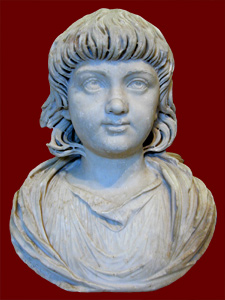 Portrait bust, 2nd century CE
Portrait bust, 2nd century CE
Extant texts and artifacts tell us how important children were in the ancient world. Among the elite, sons promised continuity of the family name while daughters could forge alliances for family through bethrothal. As adults, children were expected to tend their parents' tomb and honor the spirits of their ancestors at festivals for the dead. In poorer families all children worked to support the family, while in large families daughters might be exposed or sold into slavery to eliminate the expense of their upkeep and dowry. A child's birth was not celebrated until its eighth day of life and parents were given thirty days to register the birth with the state. For girls at all class levels, puberty was the defining limit of childhood, when the onset of menarche proclaimed the transformation of a girl from puella to virgo viripotens (maiden physically able to produce children). While boys celebrated the rite of adoption of the toga virilis as a marker of their entrance into manhood, the equivalent rite for girls was marriage and the adoption of the matronal stola. Despite the opinion of physicians who warned of the possibility of miscarriage and female death from early sexual actrivity, social and cultural emphasis on marriage as the only sanctioned venue for female sexuality and the production of legitimate children made the social transition from virgo to uxor and materfamilias a brief one. Although Augustan legislation set the age of twelve as the legal minimum age when a girl could be married, wealthy families were known to arrange advantageous betrothals as early as a girl's infancy. Tombstones testify to the many dangers of childhood in the ancient world. Mortality was high: about a third of live newborns died within their first year while almost half of all children born died by age ten. Sarcophagi and grave goods give evidence of the love and grief felt by parents upon the loss of a child. For further information on the topic of childhood, see Caldwell (2015), Carroll (2018), Rawson (2003), Uzzi (2005), in the Bibliography; Classical Girls Exhibit at the Girl Museum; Images of Childhood below.